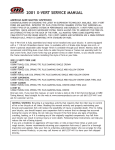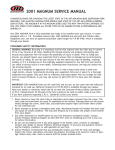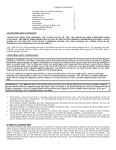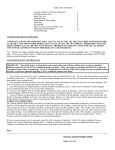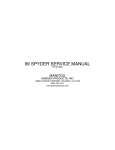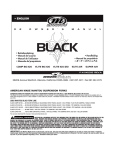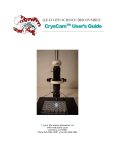Download X-Vert Service Manual
Transcript
TABLE OF CONTENTS Consumer Safety & Warranty Information Installation Instructions . . . . . Spare Parts List . . . . . . . Exploded View . . . . . . . Maintenance & Disassembly. . . . Inspection. . . . . . . . . Reassemble . . . . . . . Inner Fork Leg, Crown. & Brake Arch . Adjusting the Ride Qualities. . . . Trouble Shooting. . . . . . . . . . . . . . . . . . . . . . . . . . . . . . . . . . . . . . . . . . . . . . . 1 2 3 4 6 8 8 9 10 11 ANSWER PRECISION SUSPENSION Congratulations for choosing the latest state of the art mountain bike suspension fork available. All 2000 Xvert fork models are sprung with a state of the art spring/MCU compression system. Likewise, all Xvert suspension forks use the new advanced Twin Piston Chamber Plus damping system (TPC +) that surpasses all other damping systems in performance, reliability and durability. Your 2000 X-vert Fork is fully assembled and ready to be installed onto your bicycle. Your fork is equipped with a 1-1/8” threadless steer tube and has been designed for use with V-Brakes (except the Xvert-Carbon, which can only use disc brakes). However, if your bicycle uses cantilever brakes a cable hanger kit (P/N 85-3800) is available through your dealer (not compatible with the XvertCarbon). CONSUMER SAFETY INFORMATION GENERAL WARNING: Bicycling is a hazardous activity that requires the rider stay in control of his or her bicycle at all times. Reading this manual entirely and properly maintaining your bicycle and suspension fork will reduce the possibility of injury or death. Prior to riding your bicycle, you should inspect your suspension fork to ensure that no damage has occurred during the course of riding. Do not ride your bicycle if the fork or shock shows any signs of bending, cracking, leaking, or if it is missing any of the originally supplied components. Any fall from your bicycle can result in serious injury or death. Following these instruction can help you reduce the risk of being injured. If you are a moderate or aggressive off-road rider, or ride at least three times a week over rough terrain, Answer recommends returning your suspension fork every 2 years for a through inspection. To do this, you will need to take your fork to a Manitou authorized dealer who can arrange for shipment to Answer Products, or you may call Answer to have your fork shipped directly at (661) 257-4411. IMPORTANT: All 2000 Xvert forks are off road forks and as such, do not come with the reflectors for on road use installed. However, a reflector bracket kit (P/N 85-3674) is available through your dealer. Your dealer or mechanic can install the kit to meet all Consumer Product Safety Commission's (CPSC) requirements. If you have any questions regarding CPSC Standards, please contact your dealer. 1. 2. 3. 4. 5. Never remove or have the steer tube or stanchions (inner legs) removed from the crown. The steer tube and stanchions are pressfitted into the crown at the factory. Pressing them out will permanently damage the crown, steer tube, and stanchions beyond repair and thus, render them unsafe for any further use. Never attempt to thread a threadless steer tube. Machining threads will weaken the steer tube and cause an unsafe condition. The only safe alternative is to obtain the proper crown/steerer from your dealer. Any other alterations or modifications to your fork should be considered unsafe. Please contact Answer Products technical support for safety information prior to modifying your fork in any way. Do not use your Manitou fork if any part appears to be broken, bent, cracked, or damaged in any way. Contact your dealer or Answer Products technical support, (800) 670-7446, if you have any questions concerning the integrity, condition, or safe operation of your fork. Answer Products recommends that you periodically inspect your fork for wear and damage. Inspect the crown, inner legs, and outer leg dropout and brake arch areas for cracks or damage. Before every ride check to ensure the proper spring preload exists. WARRANTY INFORMATION Any Answer Products fork found by the factory to be defective in materials and/or workmanship within one year from the date of purchase will be repaired or replaced at the option of the manufacturer, free of charge, when received at the factory, freight prepaid. This warranty does not cover breakage, bending, or damage that may result from crashes or falls. Likewise, this warranty does not cover any fork that has been modified, has been subject to misuse or whose serial number has been altered, 1 defaced or removed. This warranty does not cover paint damage. Any modifications made by the user will render this warranty null and void. This warranty is expressly in lieu of all other warranties, and any implied are limited in duration to the same duration as the expressed warranty herein. Answer Products shall not be liable for any incidental or consequential damages. If for any reason warranty work is necessary, return the fork to the place of purchase. In the USA, dealers should call Answer Products for a return authorization number (RA#). At that time instructions for repair, return, or replacement shall be given. Customers in countries other than USA should contact their dealer or local distributor. INSTALLATION INSTRUCTIONS Figures 1, 2, & 3: Insure that the proper steer tube has been delivered on your fork. The steer tube may need to be cut to length to fit your bicycle head tube. If you are not familiar with this procedure or do not have the proper tools to cut the steer tube it is recommended that you seek a dealer with a qualified bicycle mechanic to perform installation. WARNING: The steer tube and stanchions (inner legs) are a one time precision press fit at the factory and cannot be removed from the crown. Replacement of the entire crown/steerer assembly must be done to change steer tube lengths or diameters. Removing and replacing the steer tube or stanchions will result in an unsafe condition and should never be done. 1. 2. 3. Remove old forks from bicycle. Measure and cut the steer tube to fit your bicycle head tube. Remove crown race from old forks and press it onto the steerer until it is seated on crown. 4. Clean and grease headset bearing and races of bicycle. 5. Install lower bearings on fork crown race (if applicable). 6. Install steer tube into head tube frame. 7. Install upper bearing, spacers, and stem. For the Xvert-DC and Xvert-carbon, install the upper triple clamp before the stem. 8. Install stem cap, adjust and tighten headset per manufacturer’s instructions. 9. Install handlebars to desired height. Torque stem handlebar pinch screw and stem clamping system to manufacturer’s instructions. 10. Install brakes and adjust per the manufacturers instructions. 11. Adjust fork wheel quick release to clear the 0.275” (7MM) thick secondary catch dropout. The quick release must be tightened after it is properly seated into the dropout counter bores. Be sure to verify that there is adequate thread engagement (4 or more threads with the release adjusted lock) due to the wider adjustment of the 2000 XVERT forks. 12. Install brake cable per manufacturers instructions. Note: All 98, 99 & 2000 Xvert forks (excluding the Xvert-Carbon) are equipped with a secondary catch dropout. FIGURE 2: BREAK CABLE ROUTING Note: All 98, 99 & 2000 Xvert forks (excluding the Xvert-carbon) are equipped with a hangerless arch. A brake cable hanger kit that attaches to the arch is available through your dealer. See Figure 2 WARNING: When installing wheel or any new tire check the minimum tire clearance. Measure from the highest point on the tire to the bottom of the crown. The minimum clearance allowed for 105MM travel fork models is 4.252”(108.0MM), for 120MM travel fork models is 4.843” (123.0MM) and for 180MM travel fork models is 7.205” (183.0MM). Any less clearance can result in accident resulting in serious injury or death. Figure 3 FIGURE 3: TIRE CLEARANCE SPARE PARTS: Table 1 Spare parts can be ordered through your local dealer. If you have any problems that you cannot resolve with your dealer, you may call Answer Products technical/warranty service department at (661) 257-4411, 8:00 AM to 5:00 PM, Pacific Standard time, Monday through Friday. In addition helpful information can be found on the Answer Products web site at http://www.answerproducts.com. where you may download manuals and e-mail us for technical support. DESCRIPTION 2000 X-VERT & X-VERT SUPER FIRM RIDE KIT 2000 X-VERT & X-VERT SUPER MEDIUM RIDE KIT 2000 X-VERT & X-VERT SUPER SOFT RIDE KIT 2000 X-VERT RED OUTER ASSEMBLY 2000 X-VERT FIREBALL OUTER ASSEMBLY 2000 X-VERT BLACK OUTER ASSEMBLY 2000 X-VERT YELLOW OUTER ASSEMBLY PART NUMBER 85-9099 85-9178 85-9100 85-9144 85-9094 85-9091 85-9092 2 2000 X-VERT SUPER FIREBALL STICKER KIT 2000 X-VERT SUPER RED STICKER KIT 2000 X-VERT BLACK STICKER KIT 2000 X-VERT YELLOW STICKER KIT 2000 X-VERT BUSHING & SEAL KIT 2000 X-VERT SUPER PAD ASSEMBLY KIT 2000 X-VERT SUPER LOWER SHAFT ASSEMBLY KIT 2000 X-VERT DC FIRM RIDE KIT 2000 X-VERT DC SOFT RIDE KIT 2000 X-VERT CARBON FIRM RIDE KIT 2000 X-VERT CARBON SOFT RIDE KIT 2000 X-VERT DC BLUE OUTER ASSEMBLY 2000 X-VERT CARBON OUTER ASSEMBLY 2000 X-VERT DC BLUE FIREBALL STICKER KIT 2000 X-VERT CARBON STICKER KIT 85-4099 85-9170 85-4095 85-4096 85-9095 85-9085 85-9084 85-9101 85-9102 85-9080 85-9079 85-9093 85-9077 85-4097 85-4098 3 4 FIGURE 5 5 FIGURE 6 6 FIGURE 7 7 MAINTENANCE IMPORTANT: Your Xvert fork should not be used if any parts appear to be damaged. Please contact your local dealer or Answer Products for replacement parts. IMPORTANT: The fork boots are required to keep your 2000 Xvert (excluding the Xvert-Carbon) performing well and your warranty in effect. Use of this fork without the boots will shorten the life of the fork, reduce the performance and void the warranty. Your 2000 Xvert fork requires periodic maintenance, cleaning, and inspection. Moisture and contamination may build up inside the fork depending upon the severity of riding conditions. To maintain top performance, it is recommended that the fork be periodically disassembled, cleaned, dried and re-greased using the grease ports on the back of each leg. Figure 8 IMPORTANT: When filling the fork with grease through the Microlube ports, it is important to note the grease is filling the space between the upper and lower bushings. If this area is overfilled, the force of the grease may force the upper bushings and dust seals out. IMPORTANT: Before every ride you should: 1. 2. 3. 4. Ensure that quick release skewers are properly adjusted and tight. Wipe the inner legs clean, lubricate and check the entire fork for any obvious damage. Check headset adjustment. Insure the front brake cable is properly seated in the cable retainer & verify proper brake adjustment. IMPORTANT: Maintaining the proper oil level in your TPC + damping system is very important. Insufficient oil will allow foaming and reduce the damping performance. Whereas, too much oil will restrict travel and may cause damage to the system and an unsafe riding condition. Finish reading this entire section prior to making any changes to the oil level. To check the oil level; remove the compression damping assembly located in the top of the right leg. Leave the left side compression stack (adjuster, MCU, spring assembly) in place to keep the fork fully extended. Use a tape measure or “dip stick” to determine the oil level. It is recommended that you replace your oil at least once during the season, or twice if it has been contaminated with dirt, mud, or any other substance. Use SAE 5WT Maxima fork oil or equivalent. Refer to Figure 9 for the recommended oil level, or for a specific fork models refer to table 2. FIGURE 8: LUBRICATING BUSHINGS OIL LEVEL TABLE: 2 Fork Model Maximum Minimum Xvert 3.50"(89MM) 4.0"(102MM) Recommended Xvert-DC 8.0"(203MM) 10.0"(254MM) 9.0"(229MM) Xvert-SUPER 3.50"(89MM) 4.0"(102MM) 3.75"(95MM) Xvert-CARBON 7.0"(178MM) 9.0"(228MM) 8.0"(203MM) 3.75"(95MM) FIGURE 9: TPC OIL LEVEL GENERAL DISASSEMBLY NOTE: Your fork does not need to be removed from the bicycle for general disassembly or cleaning. Furthermore, it is not necessary to disassemble your fork to service the spring stack or to change the oil height. You may service the spring stack by removing the adjuster assembly as shown in Figure 11. 8 Removal of outer leg, Figure 10: 1. Use a 4MM Allen wrench to remove the M6 lower compression rod screw from the left leg side. 2. Pop out the damping adjuster knob from the right side (a small screwdriver may be helpful). Use an 8MM allen wrench to remove the dropout nut (it may be helpful to compress the fork to prevent the compression rod and damper shaft from turning while removing these screws). 3. Pull the outer leg assembly off the inner legs and crown assembly. 4. Remove the fork boots. 5. Bushing replacement will require the use of the bushing removal and installation tool available from Answer Products. It is recommended that the bushings be left installed unless they absolutely need replacement. FIGURE 10: OUTER LEG REMOVAL Note: It is not recommended to remove the dust seal every time the fork is disassembled. The seal and bushings may be cleaned and re-greased in place. Spring Stack & Compression Rod Removal, Figure 11: 1. Unscrew and remove the spring adjuster assembly. 2. Unscrew the end cap from the left inner leg and pull the compression rod out of the inner leg. Lower Shaft Disassembly, Figure 12: Note: Lower Shaft removal/disassembly is best done with the fork removed from the bicycle. Disassembly of the damping assembly is not required unless you want to modify or replace the shim stack. FIGURE 11: SPRING STACK & COMPRESSION ROD FIGURE 12: LOWER SHAFT ASSEMBLES 1. 2. 2. 3. Unscrew and remove the TPC + compression damping assembly from the top of the right leg and discard the oil appropriately. Unscrew the end cap and pull the lower shaft assembly out of the inner leg. Remove the bottom out elastomers and capture the 1/8” dia. detent ball. The adjuster needle may be unscrew and removed from the shaft. However, this is not recommended. 9 4. Remove the valve nut to change the shim stack. It is recommended that you write down the order of the factory specified shim stack and spacers before you begin revalving. Thus, you will always be able to easily revert to the factory set-up. FIGURE 13: TPC +& COMPRESSION DAMPING ASSEMBLY 1. 2. 3. 4. 5. Unscrew the compression damping adjuster until it stops. Do not remove the shaft from the cap because the threads are bonded to prevent leaking. Unscrew the button head screw from the bottom of the assembly. Remove the O-ring, floating piston assembly and spring. You may disassemble the floating piston assembly to modify the shim stack. However, it is recommended that you use the precautions mentioned in the instructions for disassembly of the lower shaft assembly. Remove either the floating piston shaft or the piston seat following the instructions above for the lower shaft assembly. DAMPER INSPECTION 1. Inspect the shaft for scratches, wear, or other obvious damage. 2. Inspect the seal gland and end cap seal grooves for damage. 4. Inspect shims for permanent bends or damage. 5. Inspect all other parts for obvious damage, and replace as necessary. 6. Replace all seals that have been removed. FORK INSPECTION 1. Inspect the fork boots for obvious damage. 2. Inspect the dust seal for tears, wear, or damage. Replace as needed. 3. Inspect the lower and upper bushing for damage to the Teflon coating. Replace using the bushing removal and replacement kits if necessary. 4. Inspect all MCU’s & springs for obvious damage. Replace as necessary. 5. Inspect the preload adjuster and connectors. Replace if damaged. 6. Check the outer legs for nicks or deep gouges on the outside and inside. Replace if damaged. 7. Check the inner legs for deep gouges or any other obvious damage. Slight wear resulting in a color change is not detrimental to the gold anodized surface. Replace the crown/leg assembly if wear is excessive or if they are damaged. 8. Check inner legs at the bottom of the crown for cracks or for flaking of the anodizing. Replace crown/leg assembly if cracked or if gold anodize is beginning to flake. 9. Check the crown for cracks. Replace if cracked. REASSEMBLY: Lower Shaft Figure 12: Install all previously removed O-rings and seals. 1. Lightly grease all seals with seal grease. 2. Apply a small amount of blue Loktite to piston seat threads. 3. First, reassemble shim stack, spacers and piston in exact order they were removed. Next, thread the valve nut onto the piston seat and torque it to 12 IN-LB (1.2 N-M) max. 4. Install lower needle gently into shaft, thread until it stops then back off one turn for initial adjustment. 10 5. 6. 7. Slide shaft assembly through the plastic end cap. Slide an elastomer onto the shaft followed by the cup spacer. Next, place the detent ball in its hole and slide another elastomer over it. Note: The Xvert-DC & Xvert-Carbon do not use the cup washer and 2nd elastomer. Therefore, the first elastomer is used to retain the detent ball. Insert into right leg and thread in end cap. Torque 30 IN-LB (3.5N-m) max. Compression Damping Assembly Figure 13: 1. 2. 3. 4. Install all previously removed O-rings. Apply a small amount of blue Loktite to piston seat threads. Reassemble shim stack, spacers and pistons in exact order they were removed. Next, thread the valve nut onto the sliding piston assembly. Likewise, thread the sliding piston shaft onto the piston seat and torque them both to 12 IN-LB (1.2 N-M) max. Then, install an O-ring and the sliding piston spring onto the sliding piston shaft. Slide the sliding piston assembly onto the shaft and then slide another O-ring onto the shaft behind the sliding assembly. Finally, screw the button head cap screw with blue Loktite applied to it into the sliding piston shaft. Install compression damping assembly into the right leg. Refer to the oil level chart on page 10 to determine the proper oil height. Compression Rod & Boots Figure 14: 1. 2. 3. 4. 5. Clean all parts thoroughly. Grease compression rod lightly. Be sure rebound Elastomer is installed onto compression rod. Insert the compression rod through the end cap. Slide on a bottom-out bumper followed by the cup washer and then another bottom out bumper. Note: The Xvert-DC & XvertCarbon do not use the cup washer and 2nd elastomer. Slide Boots onto inner leg (boots are not used on the Xvert-Carbon). FIGURE 14: COMPRESSION ROD & BOOT FIGURE 15: OUTER LEG ASSEMBLY Outer Leg Assembly Figure 15: 1. 2. 3. 4. Slide outer assembly onto inner legs and fully compress. Install and torque the 5MM compression rod screw and dropout nut to between 10 and 30 inch-lb. (1.1-3.5 N-m). Over torquing the dropout nut may damage the damper shaft. Pop in the damper adjuster knob. An O-ring holds the knob in place. For all Xvert models except the Xvert-Carbon, slide the skirt of the fork boots over the flange on the upper seal. Be sure the lip snaps into the groove. 11 5. Clean the adjuster cap threads and the threads on the inside of the inner leg thoroughly. 6. Assemble MCU’s, springs, and connectors with thick grease. 7. Install adjuster assembly into inner leg and torque to within 20 and 30 inch-lb. (2.3-3.5 N-m). INNER FORK LEGS & CROWN The inner fork legs and steer tube are press fitted into the crown and may never be removed. Removing them will make the fork unsafe to use. Should any slippage occur, contact Answer Products Technical Staff immediately at (800) 670-7446. BRAKE ARCH NOTE: The 2000 XVERT outer leg/arch is a one-piece Magnesium casting. Thus, if it is damaged it must be replaced. Using the fork with damage to the outer leg/arch casting is unsafe and could cause serious injury. Please contact Answer Products if you suspect that your brake outer leg/arch is damaged. ADJUSTING RIDE QUALITIES All 2000 XVERT TPC+ forks offer a wide adjustment range to suit individual riding preference and rider weight. Fine tuning adjustments can achieved by using the preload adjusters located on top of the fork crown. NOTE: Since 98 and newer Xvert model forks use a spring stack in only one leg, the MCU’s and Springs used in previous Manitou forks are NOT interchangeable. Compression Spring Stack Fine-Tuning: Figure 16 Fine tuning adjustments to the spring rate are made by rotating the left adjuster knob located on top of the crown. Rotating the knob clockwise will firm the ride by adding preload to the spring stack. Likewise, rotating the knob counter clockwise will soften the ride. Compression Damping Fine-Tuning: Figure 17 Fine tuning adjustments to the compression damping are made by rotating the right adjuster knob located on top of the crown. Rotating the knob clockwise will increase damping, whereas rotating the knob counter clockwise will reduce damping. Excessive compression damping will give you a harsh ride over high speed bumps, but will feel good during slower speed fork compression. Furthermore, insufficient compression damping will allow the fork to bottom-out in large hits and could cause the fork to bob a little while climbing but feel plush on the sharp hits. A correctly adjusted fork will perform good in all conditions. FIGURE 16: PRE-LOAD Rebound Damping Fine Tuning: Figure 18 To adjust the rebound damping simply rotate the rebound damping knob located on bottom of the right leg. Rotating the knob clockwise will increase the damping, whereas, rotating the knob counter clockwise will reduce the damping. Excessive rebound damping will give you a harsh ride over repetitive bumps (like braking bumps) because the fork will pack up. Insufficient rebound damping will make the fork over active, top out and slap back when landing from a jump. We suggest that you try adjusting your fork on the very active side, minimum rebound. Then try it over a variety of terrain and tune in more rebound from there. 12 FIGURE 17: COMPRESSION DAMPING For additional tuning tips we recommend that you obtain a copy of the MRD tuning Manual P/N 85-3485 and check out the MRD Race Tuning kits available at your dealer. FIGURE 18: REBOUND DAMPING TROUBLE SHOOTING Fork seems to "top out" or has a slight clunking feel when front wheel comes off the ground: Excessive preload or insufficient rebound damping will result in a "top out" . Select MCU’s that better fit your weight and riding style, having the preload adjuster set mid to low range, and increase the rebound damping to eliminate "top out". The fork feels less active and is not getting the travel it used to when it was new: Chances are that the fork is developing stiction. Clean and recharge your fork with oil. Outer legs feel loose on inner legs and bushings, a knock or rock can be felt when pushed from side to side: A very small knock is normal on all 2000 Manitou forks. If the knock is excessive or you can feel the fork rocking then the bushings should be removed and replaced. To do this you must have the Answer Products Bushing Removal and Replacement Tool Kit. A small amount of oil seems to be leaking from top of the left leg at the adjuster cap: If the 2000 XVERT is store upside down for a period of time a small amount of oil may leak through the adjuster cap / knob assembly. The cap area is not subjected to damping pressure. A small leak in that area will not affect the performance of the fork or cause any type of damage. We recommend that you store your Manitou right side up. If this condition causes you some problems please contact your Answer Products dealer or call our warranty tech department for prompt service. CYCLE COMPUTER INSTALLATION INSTRUCTIONS: Follow the instructions in your owners manual with the following exceptions: WARNING: DO NOT DRILL A HOLE IN THE DROPOUT. THIS MAY WEAKEN THE DROPOUT, WILL VOID THE WARRANTY, AND MAY CAUSE AN UNSAFE CONDITION WITH RISK OF INJURY. DO NOT USE THE TEMPLATE PROVIDED IN THE 95 OR 96 SERVICE MANUAL. 2000 XVERT SERVICE MANUAL P/N 85-3690 13 MANITOU ANSWER PRODUCTS, INC 28209 AVENUE STANFORD, VALENCIA, CA 91355 (661) 257-4411 www.answerproducts.com 14














